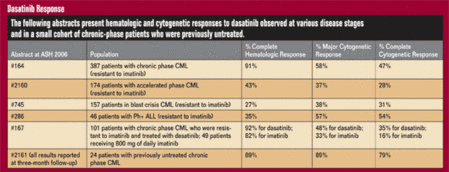Dasatinib requires further validation in imatinib-refractory patients
Several ASH abstracts show the new drug has significant effects on hematologic and cytogenetic response.
In a recent report of long-term outcomes from the pivotal IRIS trial of imatinib, Druker and colleagues reported 83% event-free survival and 93% of patients had not progressed to accelerated phase or blast crisis.
|
|
Despite these impressive results, patients with leukemia resistant to imatinib (Gleevec, Novartis) have been more frequently seen. The newly approved drug dasatinib (Sprycel, Bristol-Myers Squibb) is indicated for patients refractory or resistant to imatinib, but just how well does it work?
TK inhibitors
Tyrosine kinase inhibitors have revolutionized the treatment of chronic myeloid leukemia. The Philadelphia chromosome BCR-ABL translocation seen in CML codes for a fusion protein and allows for activation of ABL kinase activity. Imatinib was the first ABL kinase inhibitor approved for the treatment of CML, and it is the recommended first-line therapy for CML.
Mechanisms of imatinib-resistance generally involve BCR-ABL mutations that interfere with imatinib binding. AMN107 (Nilotinib, Novartis), an investigational tyrosine kinase inhibitor, binds more tightly to the ABL kinase site. Dasatinib is a newly approved tyrosine kinase inhibitor for the treatment of CML that is resistant to imatinib or in CML patients intolerant to imatinib. Dasatinib binds to the ABL kinase in different conformations of the ATP binding site. It is active against BCR-ABL mutants, except for cells with the T315I mutation, and it is also an alternative therapy for patients with Philadelphia chromosome–positive acute lymphoblastic leukemia who are intolerant or resistant to imatinib.
|
|
Dasatinib dose
Dasatinib is an orally available multitargeted inhibitor of tyrosine kinases, including the SRC family and other kinases in addition to the ABL kinase. The usual starting dose is 70 mg orally twice daily. Patients continue on the drug until disease progression or intolerable adverse effects. Physicians can increase the dose to 90 mg or 100 mg twice daily for patients who do not achieve a good response. If significant myelosuppression develops, physicians should halt treatment and restart it at a lower dose when symptoms resolve. Dasatinib is available in 20 mg, 50 mg, and 70 mg tablets.
The P450 CYP3A4 enzyme in the liver metabolizes dasatinib and it is eliminated in the feces. There is a potential for drug interactions with agents that inhibit or induce the activity of CYP3A4. Inhibitors, such as azole antifungals, clarithromycin, protease inhibitors, verapamil, nefazodone and others, can increase the dasatinib levels. If concomitant therapy is needed, careful monitoring and a dasatinib dose reduction may be needed. CYP3A4 inducers, such as rifampin, dexamethasone, phenobarbital, carbamazepine, St. John’s Wort and others, could reduce dasatinib levels, so a dasatinib dose increase may be needed. Antacids, proton-pump inhibitors and H2-blockers can reduce absorption of dasatinib and should be avoided.
The drug has not been studied in pediatric patients or in patients with decreased hepatic or renal function.
One of the most frequent serious adverse effects is reversible myelosuppression, which occurs 48% to 83% of the time. The effect is most common in patients with advanced CML and in patients with Philadelphia chromosome–positive acute lymphoblastic leukemia. Other serious adverse effects include pleural effusions (occurring 8% to 22% of the time and more frequently appearing in patients on higher dasatinib doses), diarrhea, nausea, rash, edema and bleeding events.
Phase-1 data
Talpaz and colleagues recently published the results from a phase-1 dose-escalation trial that included patients with CML or Philadelphia chromosome–positive acute lymphoblastic leukemia. Dasatinib was administered in doses ranging from 15 mg to 240 mg per day. Although the trial was designed to look at tolerability and safety of dasatinib, they found that 37 of 40 patients in chronic phase had complete hematologic responses. Further, 31 of 44 patients in accelerated phase, blast crisis or with Philadelphia chromosome–positive acute lymphoblastic leukemia had major hematologic responses.
Preliminary results from a series of phase-2 trials with dasatinib were presented at the 18th Annual Meeting of the American Society of Hematology. The abstracts were published in Blood.
Although these results are preliminary, dasatinib shows great promise in the treatment of patients with CML and Philadelphia chromosome–positive acute lymphoblastic leukemia resistant or intolerant to imatinib. Patients will require careful monitoring for myelosuppression, fluid retention/pleural effusions and potential drug interactions. Further research will help define additional roles for dasatinib in the treatment of CML.
For more information:
- Lisa K. Lohr, PharmD, BCPS, BCOP, is Clinical Leader of Oncology and Bone Marrow Transplantation in the Department of Pharmacy Services at the University of Minnesota Medical Center, Fairview. She is also the Pharmacology section editor of Hem/Onc Today.
- Druker BJ, Guilhot F, O’Brien SG, et al. Five-year follow-up of patients receiving Imatinib for chronic myeloid leukemia. N Engl J Med. 2006;355:2408-2417.
- Talpaz M, Shah NP, Kantarjian H, et al. Dasatinib in imatinib-resistant Philadelphia chromosome-positive leukemias. N Engl J Med. 2006;354:2531-2541.


